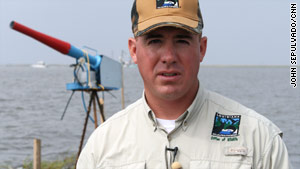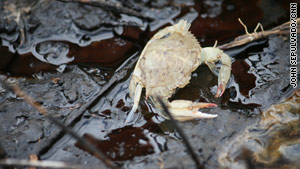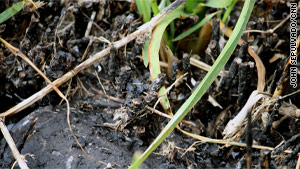The Antarctic ozone hole is about one-third to blame for Australia's recent series of droughts, scientists say.
Writing in the journal Science, they conclude that the hole has shifted wind and rainfall patterns right across the Southern Hemisphere, even the tropics.
Their climate models suggest the effect has been notably strong over Australia.
Many parts of the country have seen drought in recent years, with cities forced to invest in technologies such as desalination, and farms closing.
The scientists behind the new study - led from Columbia University in New York - added the ozone hole into standard climate models to investigate how it might have affected winds and rains.
"The ozone hole results in a southward shift of the high-latitude circulation - and the whole tropical circulation shifts southwards too," explained Columbia's Sarah Kang.
Of particular interest was the southward migration of the Southern Hemisphere jet stream.
But there are regional differences, particularly concerning Australia.
"In terms of the average for that zone, [the ozone hole drives] about a 10% change - but for Australia, it's about 35%," Dr Kang told BBC News.
Their modelling indicated that global warming due to greenhouse gas emissions was also a factor - although natural climate cycles are also thought to be important, as Australia suffered severe droughts in the era before ozone depletion and before the warming seen in the late 20th Century.
"This study does illustrate the important point that different mechanisms of global change are contributing to the climate impacts we're seeing around the world," observed Professor Myles Allen of Oxford University, a leading UK climate modeller.
"It's very important to unpack them all rather than assuming that any impact we see is down simply to greenhouse gas-mediated warming."
No reverse Ozone depletion is caused by chemical reactions in the stratosphere, the upper atmosphere.
The chemicals involved derive from substances such as chlorofluorocarbons (CFCs) and their relatives, which used to be staples in air-conditioning, refrigeration and aerosol cans.
 Desalination is one of the approaches being used to combat Australia's dwindling supply of water Although the UN Montreal Protocol has significantly curbed emissions of these substances, they endure for decades in the atmosphere, and so their effects are still being felt.
Desalination is one of the approaches being used to combat Australia's dwindling supply of water Although the UN Montreal Protocol has significantly curbed emissions of these substances, they endure for decades in the atmosphere, and so their effects are still being felt.
The ozone layer blocks the Sun's harmful ultraviolet rays, which can cause skin cancer and other medical conditions.
Earlier this month, the World Meteorological Organization revealed that the Arctic was experiencing the worst ozone depletion on record - a consequence of unusual weather conditions.
But the forecast is that even the Antarctic ozone hole - which is more severe than its Arctic equivalent - should be repaired by 2045-60.
Sarah Kang cautions that this alone will not restore prior climate conditions to Australia or anywhere else in the Southern Hemisphere.
"As the ozone hole repairs, it is going to work to reverse this trend; but there is also the rising trend in carbon dioxide, and that is acting in the same direction as the ozone hole," she said.
Australia's persistently dry weather has caused major impacts on communities, farms and nature.
In recent years, the volume of water flowing into the reservoirs of Perth, the Western Australian capital, has been just one third of what it was during most of the 20th Century.
The Murray-Darling basin, which lies in the highly populated southeast, is the subject of a somewhat controversial plan aiming to distribute water fairly against a backdrop of over-extraction, prolonged drought, natural climate variability and greenhouse gas-mediated global warming.
Writing in the journal Science, they conclude that the hole has shifted wind and rainfall patterns right across the Southern Hemisphere, even the tropics.
Their climate models suggest the effect has been notably strong over Australia.
Many parts of the country have seen drought in recent years, with cities forced to invest in technologies such as desalination, and farms closing.
The scientists behind the new study - led from Columbia University in New York - added the ozone hole into standard climate models to investigate how it might have affected winds and rains.
"The ozone hole results in a southward shift of the high-latitude circulation - and the whole tropical circulation shifts southwards too," explained Columbia's Sarah Kang.
Of particular interest was the southward migration of the Southern Hemisphere jet stream.
“Start Quote
End Quote Dr Sarah Kang Columbia UniversityThere is also the rising trend in carbon dioxide, and that is acting in the same direction as the ozone hole”
These high-altitude winds are key to determining weather patterns, in both hemispheres. Much of the cold weather felt in the UK over the last couple of winters, for example, was caused by blocking of the Northern Hemisphere stream.
The Columbia team found that overall, the ozone hole has resulted in rainfall moving south along with the winds.But there are regional differences, particularly concerning Australia.
"In terms of the average for that zone, [the ozone hole drives] about a 10% change - but for Australia, it's about 35%," Dr Kang told BBC News.
Their modelling indicated that global warming due to greenhouse gas emissions was also a factor - although natural climate cycles are also thought to be important, as Australia suffered severe droughts in the era before ozone depletion and before the warming seen in the late 20th Century.
"This study does illustrate the important point that different mechanisms of global change are contributing to the climate impacts we're seeing around the world," observed Professor Myles Allen of Oxford University, a leading UK climate modeller.
"It's very important to unpack them all rather than assuming that any impact we see is down simply to greenhouse gas-mediated warming."
No reverse Ozone depletion is caused by chemical reactions in the stratosphere, the upper atmosphere.
The chemicals involved derive from substances such as chlorofluorocarbons (CFCs) and their relatives, which used to be staples in air-conditioning, refrigeration and aerosol cans.
 Desalination is one of the approaches being used to combat Australia's dwindling supply of water
Desalination is one of the approaches being used to combat Australia's dwindling supply of water The ozone layer blocks the Sun's harmful ultraviolet rays, which can cause skin cancer and other medical conditions.
Earlier this month, the World Meteorological Organization revealed that the Arctic was experiencing the worst ozone depletion on record - a consequence of unusual weather conditions.
But the forecast is that even the Antarctic ozone hole - which is more severe than its Arctic equivalent - should be repaired by 2045-60.
Sarah Kang cautions that this alone will not restore prior climate conditions to Australia or anywhere else in the Southern Hemisphere.
"As the ozone hole repairs, it is going to work to reverse this trend; but there is also the rising trend in carbon dioxide, and that is acting in the same direction as the ozone hole," she said.
Australia's persistently dry weather has caused major impacts on communities, farms and nature.
In recent years, the volume of water flowing into the reservoirs of Perth, the Western Australian capital, has been just one third of what it was during most of the 20th Century.
The Murray-Darling basin, which lies in the highly populated southeast, is the subject of a somewhat controversial plan aiming to distribute water fairly against a backdrop of over-extraction, prolonged drought, natural climate variability and greenhouse gas-mediated global warming.












